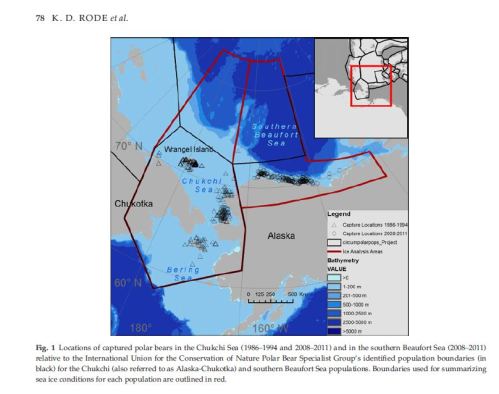 Sea ice in the Bering Sea this winter was said to be the lowest since the 1850s, largely driven by persistent winds from the south rather than the usual north winds although warm Pacific water was a factor early in the season (AIRC 2018).
Sea ice in the Bering Sea this winter was said to be the lowest since the 1850s, largely driven by persistent winds from the south rather than the usual north winds although warm Pacific water was a factor early in the season (AIRC 2018).
But what, if any, impact is this surprisingly low winter and spring ice cover likely to have on Chukchi Sea polar bear health and survival?
In fact, research on Chukchi Sea polar bears has included so few examples of individuals utilizing the Bering Sea in winter (Jan-March) and early spring (April-May) that any conclusions regarding an impact from this year’s sea ice conditions are likely to be invalid.
In short, we don’t know what will happen since it has not happened before within living memory; the opinions of polar bear specialists must be taken with a grain of salt because so many of their previous assumptions have turned out to be wrong (Crockford 2017a,b, 2018), see here,here, and here.
Seals, walrus, and polar bears are much more flexible and resilient to changes in habitat conditions than most modern biologists give them credit for and consequently, it will be fascinating to see how the ice will change over the coming months and how the animals will respond.


A sampling map from Rode et al. 2014 (below) shows only a handful of bears were captured south of the Bering Strait, virtually all in the most recent period (2008-2011), as the map from Garner et al. 1990, further below, shows (only one bear south of the Bering Strait in 1987):


Data on polar bear movements in 1986-87 from Garner et al. (1990 Fig 3D Jan-March and Fig 3A April-May) further show only a few bears captured in the Chukchi Sea ventured south into the Bering Sea in winter and spring.
Garner et al. (1990) Fig 3D Jan-March:

Garner et al. 1990 Fig 3A April-May:

This year, there was virtually no ice remaining in the Bering Sea at the end of April and this clearly represents unusual conditions.
But it is not obviously catastrophic since there is still a lot of ice in the Chukchi Sea for the Chukchi Sea bears to hunt and mate upon:

Most of the known impact of low Bering Sea ice this winter has been on humans: local hunters having to adjust their hunting schedules and polar bear specialists unable to land their helicopters safely on the ice.
Bering Sea walrus, seals, and polar bears move with the mobile pack ice and therefore any individuals that spent the winter in the Bering Sea this year (see map below) would have traveled with the ice north into the Chukchi Sea as the ice retreated earlier than usual.

Just because virtually all Chukchi Sea bears (and many seals) will have been forced to stay within the Chukchi Sea itself for most of this winter and early spring does not necessarily mean a problem ahead.
However, when people are looking for problems, that’s often all they see:
The same excellent conditions for ringed and bearded seals existed last summer (longer open water season, therefore more time for the seals to feed and fatten up for the winter) has existed since 2008 (Crawford et al. 2015; Crawford and Quakenbush 2013), so seal pups should be just as plentiful in the Chukchi Sea this spring as last spring (Rode et al. 2014, 2018).
This will allow most Chukchi bears to put on enough fat to see them through an ice-free period as long as 4-5 months, just as bears in Western and Southern Hudson Bay have done for decades (Castro de la Guardia 2017; Obbard et al. 2016).
There is no reason to expect that the well-fed Chukchi Sea bears will not be able to endure a similar fast (whether they are on the sea ice over the Arctic Basin or on land), since they have already been thriving with a fast of one month or longer in recent years (Rode et al. 2014, 2018).
However, polar bear specialist Andrew Derocher thinks that even one month of ice-free conditions will mean the demise of some Chukchi Sea bears. While he’s technically correct — some bears starve every year (usually very young and old bears) no matter how good the ice conditions — but that’s not what he’s trying to say:
Once the hunting season ends, #polarbears use ca. 1 kg (2.2 lbs) of body mass per day to sustain themselves. One month of ice-free time can be handled by some bears but not all. Proportion of population that cannot survive a fast increases sharply with ice-free period length. https://t.co/rcAQeGQ4ih
— Andrew Derocher (@AEDerocher) April 30, 2018
Sea ice cover is highly variable in the Bering Sea (Brown et al. 2011). In 2012 (when summer sea ice for the Arctic was at its lowest since satellite records began), spring ice in the Bering Sea was the highest it had been since 1979.
Spring ice cover was very low in 1979 (when summer sea ice for the Arctic was very high), covering only 130,000 km2 at the end of May compared to 350,000 km2 in 2012.
In other words, sea ice cover for the Bering Sea in spring is not a portend for what the Arctic will experience at the height of summer and the reverse is also not true: Arctic ice cover in September is not a reflection of Bering Sea ice cover in spring.
As a consequence, we shall have to wait and see what the coming months bring. Sea ice retreat in the Chukchi may stall for months or continue to decline.
It may indeed be a rough year for the Chukchi Sea polar bears but after a decade or more of excellent conditions, the population can likely rebound from a single challenging spring with less than optimal ice cover.
As far as I know, no one predicted this year’s low Bering Sea ice conditions, and there is no reason to expect it will be repeated next year or that this is a “new normal” for the region.
Read rest at Polar Bear Science

















Now if we can just get them getting shot from helicopter cowards and semi automatics from ski -doo’s .
Polar bears will be around a lot longer than the latte crowd who are being programed by Face Plant and other crap .